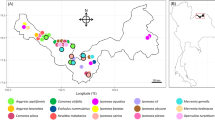Abstract
The large terrestrial orchid genus Satyrium underwent evolutionary radiations in the Cape floral region and the grasslands of southern and eastern Africa. These radiations were accompanied by tremendous diversification of the unusual twin-spurred flowers that characterize the genus, but pollination data required to interpret these patterns of floral evolution have been lacking for grassland species in the genus. Here we document pollinators, nectar properties, and levels of pollination success for 11 grassland Satyrium species in southern and south-central Africa. Pollinators of these species include bees, beetles, butterflies, hawkmoths, noctuid moths, long-proboscid flies, and sunbirds. Most species appear to be specialized for pollination by one functional pollinator group. Long-proboscid fly pollination systems are reported for the first time in Satyrium (in S. macrophyllum and a high-altitude form of S. neglectum). Floral morphology, especially spur length and rostellum structure, differs markedly among plants with different pollinators, while nectar volume, concentration, and sugar composition are fairly uniform across species. Most taxa exhibited high levels of pollination success (>50% of flowers pollinated), a trend that can be attributed to the presence of nectar in the twin spurs.


Similar content being viewed by others
References
Ellis AG, Johnson SD (2010) Gender differences in the effects of floral spur length manipulation on fitness in a hermaphrodite orchid. Int J Plant Sci 171:1010–1019
Garside S (1922) The pollination of Satyrium bicallosum Thunb. Ann Bolus Herb 3:137–154
Goldblatt P, Manning JC (2000) The long-proboscid fly pollination system in southern Africa. Ann Missouri Bot Gard 87:146–170
Goldblatt P, Manning JC, Bernhardt P (1998) Adaptive radiation of bee-pollinated Gladiolus species (Iridaceae) in southern Africa. Ann Missouri Bot Gard 85:492–517
Harder LD, Johnson SD (2005) Adaptive plasticity of floral display size in animal-pollinated plants. Proc R Soc B Biol Sci 272:2651–2657
Herrera CM (1990) The adaptedness of the floral phenotype in a relict endemic, hawkmoth-pollinated violet. 1. Reproductive correlates of floral variation. Biol J Linn Soc 40:263–274
Jersakova J, Johnson SD (2007) Protandry promotes male pollination success in a moth-pollinated orchid. Funct Ecol 21:496–504
Johnson SD (1994) The pollination of Disa versicolor, Orchidaceae, by anthophorid bees in South Africa. Lindleyana 9:209–212
Johnson SD (1996) Bird pollination in South African species of Satyrium (Orchidaceae). Plant Syst Evol 203:91–98
Johnson SD (1997a) Insect pollination and floral mechanisms in South African species of Satyrium (Orchidaceae). Plant Syst Evol 204:195–206
Johnson SD (1997b) Pollination ecotypes of Satyrium hallackii (Orchidaceae) in South Africa. Bot J Linn Soc 123:225–235
Johnson SD (2000) Batesian mimicry in the non-rewarding orchid Disa pulchra, and its consequences for pollinator behaviour. Biol J Linn Soc 71:119–132
Johnson SD (2006) Pollination by long-proboscid flies in the endangered African orchid Disa scullyi. S Afr J Bot 72:24–27
Johnson SD, Nicolson SW (2008) Evolutionary associations between nectar properties and specificity in bird-pollination systems. Biol Lett 4:49–52
Johnson SD, Steiner KE (1995) Long-proboscid fly pollination of two orchids in the Cape Drakensberg mountains, South Africa. Plant Syst Evol 195:169–175
Johnson SD, Steiner KE (1997) Long-tongued fly pollination and evolution of floral spur length in the Disa draconis complex (Orchidaceae). Evolution 51:45–53
Johnson SD, Ellis A, Dotterl S (2007) Specialization for pollination by beetles and wasps: the role of lollipop hairs and fragrance in Satyrium microrrhynchum (Orchidaceae). Am J Bot 94:47–55
Kurzweil H (1996) Floral morphology and ontogeny in subtribe Satyriinae (Fam Orchidaceae). Flora 191:9–28
la Croix IF (1991) Orchids of Malawi. A. A. Balkema, Rotterdam
Larsen MW, Peter C, Johnson SD, Olesen JM (2008) Comparative biology of pollination systems in the African-Malagasy genus Brownleea (Brownleeinae : Orchidaceae). Bot J Linn Soc 156:65–78
Manning J, Snijman D (2002) Hawkmoth pollination in Crinum variabile (Amaryllidaceae) and the biogeography of sphingophily in southern African Amaryllidaceae. S Afr J Bot 68:212–216
Ollerton J, Johnson SD, Cranmer L, Kellie S (2003) The pollination ecology of an assemblage of grassland asclepiads in South Africa. Ann Bot 92:807–834
Peter CI, Johnson SD (2009) Pollination by flower chafer beetles in Eulophia ensata and Eulophia welwitschii (Orchidaceae). S Afr J Bot 75:762–770
Shuttleworth A, Johnson SD (2009) New records of insect pollinators for South African asclepiads (Apocynaceae: Asclepiadoideae). S Afr J Bot 75:689–698
Steiner KE (2010) Twin oil sacs facilitate the evolution of a novel type of pollination unit (meranthium) in a South African orchid. Am J Bot 97:311–323
Van der Niet T, Johnson SD (2009) Patterns of plant speciation in the Cape floristic region. Mol Phylogenet Evol 51:85–93
van der Niet T, Linder HP (2008) Dealing with incongruence in the quest for the species tree: a case study from the orchid genus Satyrium. Mol Phylogenet Evol 47:154–174
Van der Niet T, Linder HP, Bytebier B, Bellstedt DU (2005) Molecular markers reject monophyly of the subgenera of Satyrium (Orchidaceae). Syst Bot 30:263–274
Van der Niet T, Zollikofer CPE, Ponce de León MS, Johnson SD, Linder HP (2010) Three-dimensional geometric morphometrics for studying floral shape variation. Trends Plant Sci 15:423–426
van Wyk B-E, Whitehead CS, Glen HF, Hardy DS, van Jaarsveld EJ, Smith GF (1993) Nectar sugar composition in the subfamily Alooideae (Asphodelaceae). Biochem Syst Ecol 21:249–253
Vogel S (1954) Blütenbiologische Typen als Elemente der Sippengliederug dargestellt anhand der Flora Südafrikas. Fischer, Jena
Vogel S (1959) Organographie der Blüten kapländischer Ophrydeen. Akad Wiss Abh Math Naturwiss 6–7:1–268
Author information
Authors and Affiliations
Corresponding author
Electronic supplementary material
Below is the link to the electronic supplementary material.
Rights and permissions
About this article
Cite this article
Johnson, S.D., Peter, C.I., Ellis, A.G. et al. Diverse pollination systems of the twin-spurred orchid genus Satyrium in African grasslands. Plant Syst Evol 292, 95–103 (2011). https://doi.org/10.1007/s00606-010-0411-1
Received:
Accepted:
Published:
Issue Date:
DOI: https://doi.org/10.1007/s00606-010-0411-1




